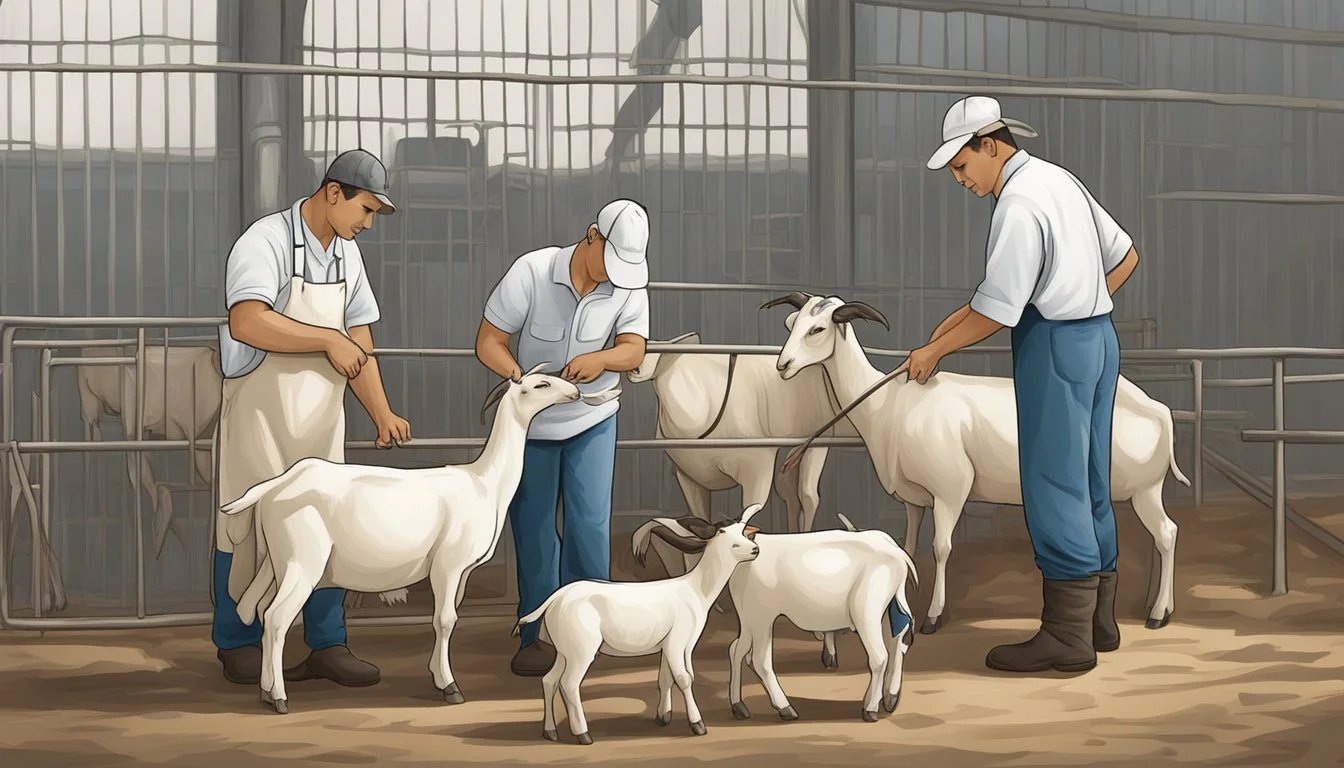Understanding Udder Health in Dairy Goats
Key Strategies for Maintaining Peak Condition
Udder health is paramount in maintaining the productivity and welfare of dairy goats. As a critical component of a dairy operation, the udder is the source of milk production and therefore a key determinant of milk quality and yield. Optimal udder health hinges on thorough understanding and diligent practice of proper care. Among the challenges to udder health, mastitis, an inflammation of the mammary gland, stands out as particularly detrimental, potentially compromising milk safety and goat well-being.
Dairy farmers and veterinarians prioritize the prevention and prompt management of udder health issues to ensure the goats' productivity and comfort. They rely on various tools, such as the California mastitis test, and practices, including proper milking hygiene and regular health checks, to identify and address problems early. Understanding the common causes of udder complications, such as bacterial infections and environmental stressors, allows for tailored interventions that can minimize the risk of disease and enhance udder health.
To support these efforts, ongoing research and accumulated field knowledge guide the development of comprehensive udder health protocols. These include advice on milking management, maintenance of milking equipment, and strategies for maintaining a clean and stress-free environment for the dairy goats. The integration of these practices forms the cornerstone of a successful dairy operation, ensuring that dairy goats remain healthy and productive, and that the milk they produce is of the highest quality.
Fundamentals of Udder Health
In dairy goats, udder health is a cornerstone of production, affecting both milk quality and herd well-being. It primarily hinges on the prevention and management of mastitis, which manifests in both clinical and subclinical forms.
Defining Udder Health
Udder health in dairy goats is determined by the absence of infection and inflammation, which is critical for optimal milk production and quality. Mastitis, an inflammation of the mammary gland, is often used as a primary indicator of udder health. Healthy udders should manifest no signs of swelling or pain, and should produce milk that is free from abnormalities.
Importance of Udder Health in Dairy Production
The importance of udder health cannot be overstated: it directly influences milk yield, quality, and safety. Moreover, the financial viability of the dairy operation is closely tied to the udder health of the herd. Effective udder health management practices can prevent production losses, reduce costs related to treatment, and extend the productive lifespan of dairy goats.
Understanding Mastitis: Clinical and Subclinical Forms
Mastitis can present in two main forms: clinical and subclinical.
Clinical mastitis is evident through visible signs in the udder such as redness, swelling, warmth, and pain, along with changes in milk consistency or color. Prompt detection and treatment are crucial to prevent severe complications or spread within the herd.
Subclinical mastitis is more insidious, as it lacks outward symptoms, making routine screening essential to detect its presence. Regular monitoring using tests, like the California mastitis test or somatic cell counts, is a proactive means to identify and manage subclinical mastitis proactively, maintaining overall udder health and milk integrity.
Dairy Goats: Anatomy and Lactation
Understanding the anatomy of goat udders and the lactation process is crucial for optimizing dairy goat health and milk production.
The Anatomy of Goat Udders
The udder of a dairy goat is a key glandular organ comprised of two halves, each with its own mammary gland. Udder composition includes teats, which allow for milk ejection, and alveoli where milk synthesis occurs. Within the alveoli are milk-producing cells, linked by a network of ducts that converge to form a larger storage area known as the gland cistern, from which milk is expelled during milking.
Lactation Process in Dairy Goats
Lactation in dairy goats is a biosynthetic process that converts blood nutrients into milk, orchestrated by the endocrine system. Initiation of lactation, or "freshening," begins post-kidding and is sustained by regular milking. Prolactin and oxytocin are key hormones; prolactin stimulates milk production, while oxytocin triggers milk let-down, a response that allows milk flow from the alveoli to the teat canal. Successful lactation management maximizes milk yield and quality while maintaining the goat's health.
Assessing and Monitoring Udder Health
Maintaining optimal udder health in dairy goats is crucial for milk production and overall herd health. Effective assessment and monitoring techniques are vital for early detection and management of mastitis and other udder-related issues.
Utilizing the California Mastitis Test
The California Mastitis Test (CMT) provides a rapid, on-farm assessment of somatic cell counts, indicative of inflammation in the udder. A small milk sample from each quarter of the udder is mixed with a reagent. The mixture's viscosity change signifies a positive reaction; a gel indicates a high somatic cell count, suggesting possible mastitis.
Interpreting Somatic Cell Counts
Goat milk's normal somatic cell count (SCC) can be higher than that of cows, making it important to understand species-specific thresholds. High SCC values often point to udder infections. Regular SCC monitoring is essential to detect any sudden increases that may warrant further investigation.
Bacteriological Culture and Other Diagnostic Tests
While bacteriological culture remains the gold standard for identifying udder pathogens, it is complemented by other tests like PCR for more rapid results. These diagnostic tests are key to identifying specific organisms, helping to tailor treatment and control strategies for udder health management.
Tracking Udder Health Status Over Time
A systematic approach to tracking udder health involves recording individual goat health data and monitoring trends over time. Documenting test results, treatments, and outcomes is essential for understanding and improving udder health status at the herd level.
Causes and Risk Factors for Udder Issues
Understanding the factors that lead to udder issues is crucial for maintaining goat health and dairy productivity. Identifying the pathogens responsible, recognizing environmental conditions, and ensuring proper housing and animal welfare are key steps to mitigating risk.
Identifying Common Pathogens
Goat udders are susceptible to infection caused by a variety of pathogens. Staphylococcus aureus is notably the most significant bacteria causing clinical mastitis in dairy goats. Another concern is non-aureus staphylococci, commonly isolated from subclinical mastitis cases. Awareness and early detection of these pathogens are paramount to preventing the spread and ensuring the health of the herd.
Understanding Environmental and Contagious Sources
Environmental streptococci represent a severe problem for udder health, indicating that pathogens present in the goat's surroundings can contribute to infection risk. Conditions such as damp bedding, poor air quality, and overcrowding are environmental risk factors that can harbor contagious agents and facilitate their transmission. Regular monitoring of the environment and maintaining hygiene standards can mitigate these risks.
Recognizing the Role of Housing and Animal Welfare
The design and maintenance of goat housing play a pivotal role in animal welfare and disease prevention. Good housing should provide ample space, clean bedding, and proper ventilation to minimize stress and contact with contaminants. Stress factors and poor animal welfare practices increase vulnerability to infections, so they should be addressed proactively to uphold udder health.
Improving Milking Management
Effective milking management is essential for maintaining high milk quality and controlling mastitis in dairy goats. This requires proper use of milking equipment and the adoption of meticulous hygiene practices to minimize the risk of infection.
Optimizing Milking Equipment and Procedures
Ensuring that milking equipment is well-maintained and properly calibrated is vital for both the health of the goats and the quality of the milk produced. Dairy farmers should:
Inspect and clean all components of the milking machine regularly to prevent the buildup of bacteria which could lead to udder infections.
Check vacuum levels and pulsation rates as incorrect settings can cause stress to the udder and may increase the risk of mastitis.
Furthermore, training milking staff on correct milking techniques reduces the chances of contamination. For instance, teats should be thoroughly cleaned and dried before milking to remove any potential pathogens.
Strategies for Reducing Infection During Milking
To minimize the incidence of infections, such as mastitis, during milking, dairy goat farmers should:
Implement a strict pre- and post-milking teat disinfection regime using an appropriate teat dip or spray.
Use individual towels for each goat to prevent cross-contamination between animals.
Monitor goats regularly for signs of mastitis and isolate any affected individuals to prevent the spread of the infection.
By prioritizing mastitis control and adhering to strict milking protocols, the health of the dairy goats and the integrity of the milk supply can be safeguarded.
Treatment and Control of Udder Diseases
Maintaining udder health in dairy goats involves both effective treatment strategies for mastitis, whether clinical or subclinical, and the implementation of control programs tailored to preventing new infections.
Approach to Treating Clinical and Subclinical Mastitis
Treating mastitis in dairy goats requires precise identification of the infection type. Clinical mastitis is visible, presenting symptoms such as swelling and changes in the milk. In contrast, subclinical mastitis is less obvious, lacking visible symptoms but detectable through milk testing for increased somatic cell counts or changes in milk composition. Treatment typically involves:
Antimicrobial Therapy: Administering appropriate antibiotics after identifying the causative agent.
Culture and sensitivity testing may guide antibiotic selection.
Supportive Care: Including anti-inflammatory drugs and hydrations to support the goat during recovery.
It's essential to adhere to withdrawal times for milk and meat when using any medication to treat mastitis, as this has direct implications for food safety.
Implementing Control Programs in Herds
Control programs are vital in managing udder health and preventing the spread of intramammary infections. Key components of a control strategy include:
Regular Screening: For early detection of subclinical mastitis.
Environmental Management: To reduce exposure to pathogens, maintenance of clean bedding, and proper sanitation can limit bacterial growth.
Proper Milking Procedures: Ensuring complete milk out, sanitizing teats pre- and post-milking, and maintaining milking equipment helps prevent new infections.
Herd Health Management: Including culling chronically infected animals and segregating infected ones to prevent disease spread.
Implementing these strategies can significantly reduce the incidence of mastitis, thereby safeguarding the health of the herd and quality of milk produced. Efficient control programs should be regularly reviewed and updated, as they are crucial for dairy goat health and udder disease management.
Maintaining Milk Quality and Dairy Performance
In the dairy goat industry, excellence in milk quality and performance hinges upon meticulous udder health management. Proactive measures and vigilant health monitoring play pivotal roles in sustaining peak production levels.
Measures to Ensure High-Quality Milk Production
Proper milking procedures are fundamental for high-quality milk production. Routine cleaning, along with disinfection of equipment and teats, prevents contamination and the spread of pathogens. According to Veterinary Clinics: Food Animal Practice, Staphylococcus aureus is the principal cause of clinical mastitis in goats, warranting thorough sanitization protocols.
Implement regular screening tests, like the California mastitis test, to detect early signs of mastitis.
Ensure proper nutrition and hydration for the herd, addressing their specific lactation needs.
Involve routine veterinary inspections to ensure timely vaccinations and parasite control.
An effective udder health program encompasses environmental management to minimize stress and contamination, and promote animal welfare. This contributes to consistent milk production and quality.
Assessing the Impact of Udder Health on Production
Udder health directly influences dairy performance; thus, monitoring indicators such as somatic cell count (SCC) is critical. Elevated SCC can indicate mastitis, leading to lower milk yields and altered milk composition.
Review herd records for trends in milk production and udder health issues.
Analyze milk composition for changes in fat and protein content, which can reflect udder health disturbances.
Recognizing the symbiotic relationship between udder health and dairy performance enables producers to make informed decisions on herd management. Maintaining a healthy udder through hygiene, regular check-ups, and environmental controls is essential for optimizing the quality and quantity of milk produced.
Advanced Topics in Udder Health Care
In the pursuit of maintaining udder health in dairy goats, certain advanced topics stand out for their depth and potential impact on herd well-being. These areas require an informed approach, taking into account genetic influences, nutritional strategies, and the latest research developments.
Investigating Genetic Factors of Udder Health
Researchers have identified that genetics play a vital role in udder health. Some goats inherit a greater natural resistance to conditions like mastitis, which is the inflammation of the udder tissue. By selectively breeding for traits associated with robust udder health, producers can gradually enhance the resilience of their herds against such diseases.
Role of Nutrition and Supplements
Proper nutrition is foundational for bolstering the immune system of dairy goats and promoting good udder health. Including specific supplements in a goat's diet, such as vitamin E and selenium, can help strengthen their defense mechanisms against infections. Balancing a diet to meet all the requirements of small ruminants is critical to prevent deficiencies that may compromise udder well-being.
Emerging Research and Innovative Solutions
The latest advancements in udder health care involve innovative solutions such as the use of teat sealants and vaccines to prevent mastitis. Ongoing research continuously explores new ways to improve milk quality and udder condition, as well as studying the correlation between udder hygiene and health outcomes. Integrating these pioneering approaches can greatly assist producers in upholding high standards of udder health in their herds.
Troubleshooting and Preventive Strategies
Effective management of udder health in dairy goats involves identifying issues promptly and applying preventive measures to reduce the incidence of diseases. It's essential to understand the troubleshooting processes and establish proactive health management protocols to protect the herd.
Addressing Recurrent Cases of Mastitis
Recurrent mastitis in dairy goats significantly impacts milk production and overall herd health. One should investigate underlying causes such as environmental conditions, milking routines, and the goats' immune status. Adapting the milking environment by ensuring cleanliness can help prevent the bacteria Staphylococcus aureus, a leading cause of clinical mastitis. Moreover, routine culture and sensitivity tests are crucial for tailoring effective antibiotic treatments.
Proactive Health Management Protocols
Proactive health management is key to maintaining healthy dairy goats. Regular screening for mastitis using the California Mastitis Test should be part of the dairy routine. Based on the guidance for udder health, it is necessary to interpret test results carefully, considering the unique aspects of caprine physiology. Establishing a routine for vaccinations and nutritional assessments can bolster the herd's defense against infection.
Common Pitfalls and How to Avoid Them
Several common pitfalls can compromise udder health in dairy goats, with negligence in milking hygiene and equipment maintenance being primary concerns. To avoid these, one should follow best practices for milking management and conduct regular maintenance checks on milking machines. Improper udder clearance during milking can also lead to milk retention and infection; therefore, training milking personnel is vital to ensure complete milk let-down.





